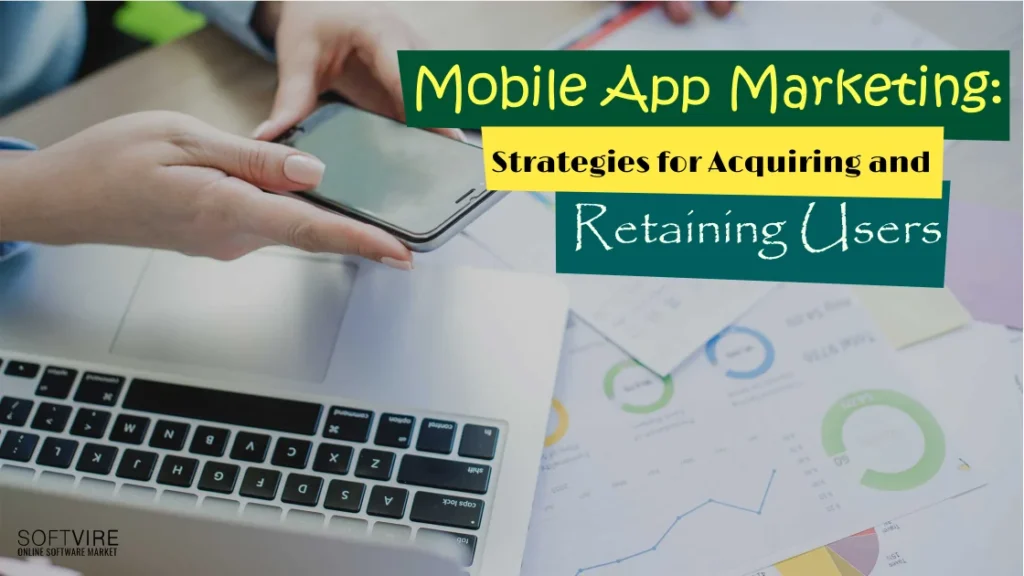I. Introduction
Mobile app marketing is crucial to promoting and driving user engagement for mobile applications. In today’s competitive app landscape, effective marketing strategies are essential to increase app visibility, attract new users, and retain existing ones.
User acquisition and retention are the cornerstones of a successful mobile app marketing strategy. User acquisition focuses on getting new users to download and install the app, while user retention emphasizes keeping existing users engaged and returning for more.
II. Understanding Your Target Audience
A. Conducting Market Research:
Market research is a critical first step in any mobile app marketing strategy. It involves gathering comprehensive data about the target audience, their preferences, behaviors, and pain points. By understanding the audience better, app developers and marketers can make informed decisions to create effective marketing campaigns.
To conduct market research, various methodologies can be employed:
1. Surveys: Designing and distributing surveys allows app owners to gather feedback from potential users. This helps understand their needs, preferences, and expectations regarding the app’s features and functionality.
2. Interviews: Conducting one-on-one or focus groups with a target audience sample can provide deeper insights into their motivations and pain points.
3. User Testing: Performing usability tests with a select group of individuals helps evaluate the app’s user experience and identify areas for improvement.
4. App Analytics: Analyzing existing app data can reveal user behavior patterns, such as the most popular features or where users drop off in the conversion funnel.
5. Social Media Listening: Monitoring social media channels and online forums relevant to the app’s niche can uncover valuable opinions and sentiments potential users share.
B. Defining User Personas and Segments:
Once the data from market research is collected and analyzed, app marketers can create user personas and segments. User personas are fictional characters representing specific user groups based on shared characteristics and behaviors. These personas allow marketers to empathize with the target audience and tailor their messaging accordingly.
To create user personas, consider the following factors:
1. Demographics: Age, gender, location, education level, and occupation are essential demographic factors.
2. Goals and Pain Points: Understand what problems the app can solve for users and what challenges they might face.
3. App Usage Behavior: Determine how frequently and in what context users will likely engage with the app.
4. Technological Proficiency: Assess the level of technical knowledge and familiarity with mobile apps among the target audience.
C. Analyzing Competitors and Their User Base:
Understanding the competitive landscape is crucial for app marketing success. Analyzing competitors helps identify their strengths and weaknesses, allowing you to position your app effectively and differentiate it from the competition.
To analyze competitors and their user base:
1. Study Competitor Apps: Use app stores to explore competing apps, noting their features, user ratings, and reviews.
2. Analyze User Feedback: Analyze user reviews and comments to understand what users like and dislike about competing apps.
3. Evaluate Marketing Strategies: Observe the marketing tactics employed by competitors and assess their effectiveness.
4. Identify Unique Selling Points (USPs): Identify areas where your app can stand out and offer something unique that differentiates it from competitors.
By conducting market research, creating user personas, and analyzing competitors, mobile app marketers can craft targeted and compelling marketing strategies that resonate with the target audience and drive user acquisition and retention.
III. User Acquisition Strategies
A. App Store Optimization (ASO):
App Store Optimization (ASO) is optimizing your app store presence to increase visibility and attract more downloads. To improve ASO, focus on the following elements:
1. Keywords: Research and select relevant keywords that users will likely use when searching for apps like yours. Incorporate these keywords naturally into your app title, description, and metadata.
2. Compelling Description: Write a clear and persuasive app description highlighting its unique features and benefits. Use words that your target audience will understand.
3. Appealing Visuals: Design eye-catching app icons, attractive screenshots, and engaging promotional videos to entice potential users.
4. Positive Reviews: Encourage satisfied users to leave positive reviews and respond to user feedback to build credibility and trust.
B. Social Media Marketing:
Social media networks offer an excellent opportunity to connect to people and create a strong brand presence. Use the following social media marketing strategies:
1. Engaging Content: Create and share compelling content related to your app, such as informative posts, visuals, and interactive content.
2. Targeted Ads: Run targeted ad campaigns on social media to reach specific user segments based on demographics, interests, and behaviors.
3. Influencer Partnerships: Collaborate with influencers with a significant following relevant to your app’s niche. Influencers can endorse and promote your app to their followers, driving app installs.
C. Influencer Marketing:
Influencer marketing is a powerful strategy that involves partnering with influencers to promote your app to their audience. Consider the following steps:
1. Identify Relevant Influencers: Look for influencers whose followers align with your app’s target audience. Consider factors like follower demographics, interests, and engagement.
2. Establish Partnerships: Reach out to influencers and propose mutually beneficial partnerships, such as sponsored posts or app reviews.
3. Authentic Recommendations: Allow influencers creative freedom to endorse your app authentically, which will resonate better with their audience.
D. Content Marketing:
Content marketing involves creating valuable, informative content to attract and engage potential users. Consider the following content strategies:
1. Blogging: Create blog posts that address common pain points, provide tips, or showcase app updates and features.
2. Video Content: Produce engaging videos demonstrating how your app works or share user testimonials.
3. Infographics: Design visually appealing infographics that present helpful information about your app’s niche.
E. App Install Campaigns:
Paid app install campaigns involves running targeted advertisements across various ad networks to encourage users to download and install your app. Follow these steps for effective app install campaigns:
1. Ad Platforms Selection: Choose suitable ad networks and platforms based on your target audience and budget.
2. Ad Creatives: Design compelling ad creatives that communicate your app’s value proposition and encourage users to take action.
3. App Install Tracking: Use app install tracking tools and analytics to measure your campaigns’ performance and make data-driven optimization decisions.
IV. User Retention Strategies
A. Onboarding Process:
A smooth onboarding process is crucial for engaging new users from the start. Focus on the following onboarding best practices:
1. Guided Tour: Offer a guided tour or tutorial that walks users through the app’s key features and functionalities.
2. Personalization: Tailor the onboarding experience based on user preferences and goals.
B. Push Notifications and In-App Messaging:
Push notifications and in-app messaging help keep users engaged and informed. Consider the following strategies:
1. Personalization: Send personalized push notifications based on user behavior and preferences.
2. Timely Updates: Push notifications announce app updates, new features, or exclusive offers.
C. Gamification Techniques:
Gamification adds an element of fun and rewards to the app experience. Implement the following techniques:
1. Reward Systems: Offer virtual rewards, badges, or points for completing specific actions within the app.
2. Challenges: Create challenges and competitions that encourage users to achieve specific goals.
D. Loyalty Programs and Incentives:
Loyalty programs encourage users to stay engaged and loyal to your app. Consider the following loyalty strategies:
1. Rewards for Actions: Offer rewards for frequent app usage, referrals, or completing specific tasks.
2. Exclusive Deals: Provide exclusive deals, discounts, or early access to premium features for loyal users.
E. Customer Support and Feedback:
Good customer support and gathering user feedback is essential for retaining users and improving the app. Implement the following strategies:
1. Multiple Support Channels: Offer multiple channels for users to seek help or report issues, such as email, in-app chat, or a support center.
2. User Feedback Collection: Encourage users to provide feedback through surveys, app store reviews, or in-app feedback forms.
V. Analyzing and Measuring Success
A. Key Performance Indicators (KPIs) for User Acquisition:
Track and analyze the following KPIs to assess the effectiveness of your user acquisition efforts:
1. App Downloads: Measure the total number of app downloads over a specific period.
2. Cost per Install (CPI): Calculate the average cost to acquire a new user through paid campaigns.
3. Conversion Rate: Determine the percentage of users who installed the app after interacting with your marketing campaigns.
4. Return on Investment (ROI): Evaluate the profitability of your acquisition strategies by comparing the acquisition cost to the app’s revenue.
B. KPIs for User Retention and Engagement:
Monitor the following KPIs to gauge user retention and engagement:
1. Retention Rate: Calculate the percentage of users who continue to use the app after a specific time.
2. Churn Rate: Calculate the percentage of users who stopped using the app during a specific timeframe.
3. User Engagement: Track metrics like session frequency, time spent in the app, and the number of active users.
C. App Analytics Tools and Their Usage:
Utilize app analytics tools to gain insights into user behavior, app performance, and marketing campaign effectiveness. Popular app analytics tools include Firebase, Google Analytics for Mobile Apps, and Mixpanel.
D. Iterative Improvements Based on Data Analysis:
Use data insights from app analytics and marketing metrics to improve your acquisition and retention strategies. Continuously test and optimize marketing efforts based on collected data to enhance app performance and user engagement.
Conclusion:
Comprehensive mobile app marketing, balancing acquisition and retention, leads to sustainable growth and long-term success in the competitive app market. Staying updated on trends ensures an engaged and loyal user base.
Are you looking for online learning tools and discounted Microsoft products? Check out our hot offers at Microsoft Softvire AU. Upgrade to the latest version of Windows 11 and unlock new features and enhanced security.



